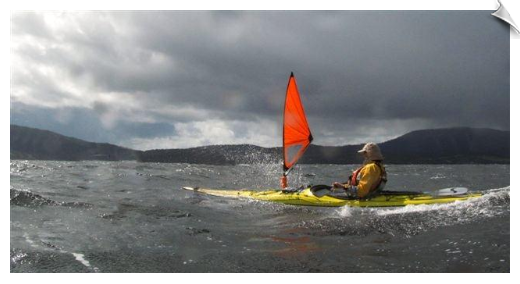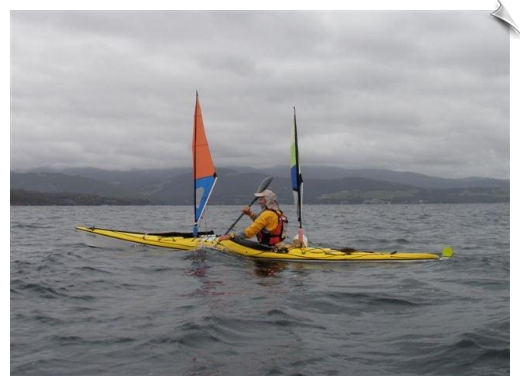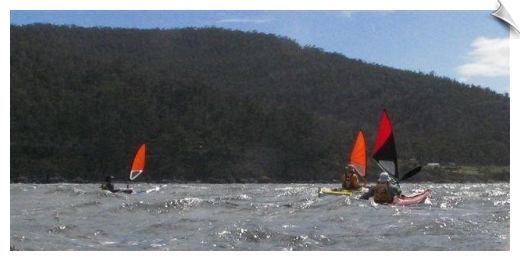Tim Parker makes a great little sea kayak sail. Feel free to contact him through the Contact Page on this site or phone him direct at 0429100849. Here are a few words from Tim explaining how and why he came up with his design…….

“When deciding on a sail for my new kayak I thought hard before making any decisions, beginning with the reasons for choosing the kayak I bought, ie; 80% of my paddles are for 2-3 hours on reasonably sheltered waters, to relax, exercise & enjoy being on the water, I wanted a responsive, exciting kayak & a sail to suit.“

Main considerations:
- Why a kayak sail at all – mainly for thrills = fresh winds.
- A sporty boat needs a sporty sail – you don’t put a truck engine in a sports car.
- Construction – in a capsize (sail up), the rig, deck & mast step must not fail.
- Weight – light, including a float to ensure it can’t sink –final weight ±650g.
- Efficient sail shape = horsepower – must have good reaching ability, fastest & most. exciting point of sailing, also control & adjustment for stronger wind.
- Size – stronger wind = one medium size sail rather than 2 sails with associated reef lines, deck clutter & extra weight.
- Ease of use through one sheeting point.
- Safety – to avoid entanglement must be bagged on deck (eg trashed in the surf).
- Cost – similar price or cheaper than other makes with advantages.
Advantages:
- The mast bends in gusts & spills wind first from the top of the sail, still giving plenty of drive down low where the capsize moment is less.
- When the gust has passed the mast & sail assume their setting & repower up.
- Many gusts & lulls pass unnoticed & even if we did ‘feel’ them all we could not react quickly enough to take advantage of them but a flexible rig automatically adjusts to these gusts & lulls.
- The mast can be bent more & sail flattened to reduce power in stronger wind.
- In a capsize the mast will bend & slowly release forces & no damage will result to rig or boat, or if the mast hits the bottom it will spring back to shape & not bend permanently as rigid masts do.
Disadvantage:
- The sail is medium size only & can’t be reefed, hence it won’t match larger sails in light winds, particularly sailing square downwind –a consideration & trade-off in the initial decision-making.
Now I’ve used the rig a few times in winds to 30 knots+, I’m pleased with the performance & convinced it’s right for its intended use & my type of kayak.

The added advantage that I had not foreseen, is that effect of gusts is softened, there are no sudden knocks and wild braces, and it’s all slower and easier than my old rigid rig.
Send me a message via the Contact Page or call me. (Mobile number on the Contact Page)
